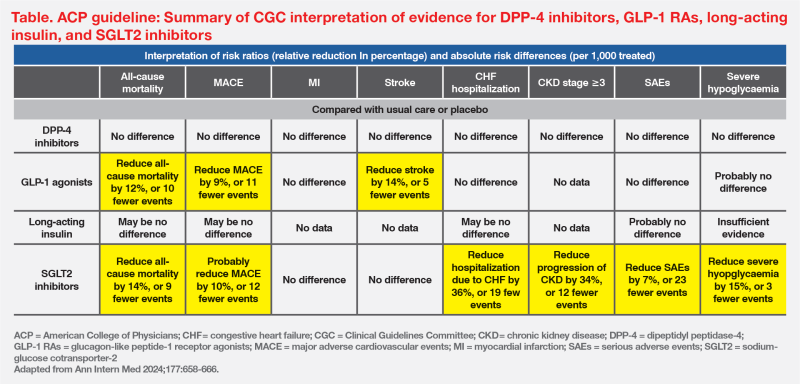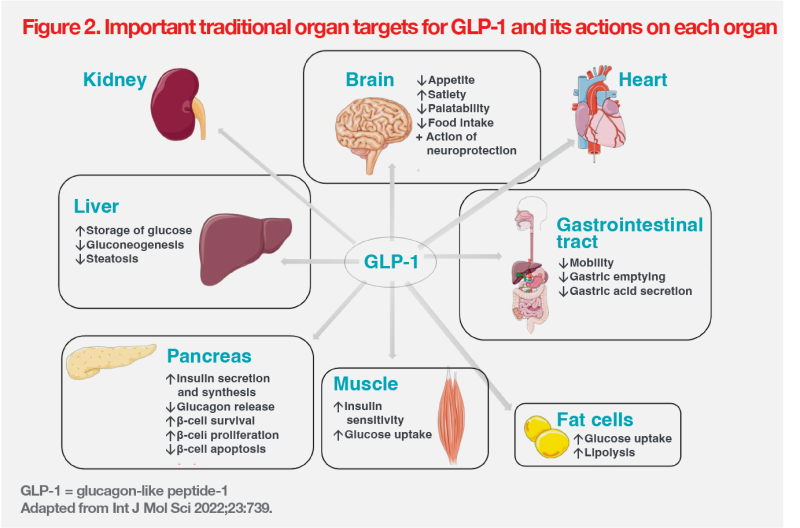The GLP-1 RA journey: From T2D and obesity treatment to cardiorenal protection





The American Heart Association defines cardiovascular-kidney-metabolic (CKM) syndrome as the overlap between metabolic, kidney, and cardiovascular diseases (CVDs). Glucagon-like peptide-1 receptor agonists (GLP-1 RAs), such as semaglutide, offer benefits that extend beyond glycaemic control and weight loss to cardiorenal protection. In a symposium, Dr Julie Lovshin of the University of Toronto, Canada, shared clinical trial data on once-weekly subcutaneous (SC) semaglutide’s cardiorenal protective effects in different CKM patient populations. She also explored characteristics of optimal candidates for GLP-1 RA treatment.
Nearly 20 years of experience
GLP-1 is an incretin hormone that was found to promote insulin secretion in 1987. In 2005, the first GLP-1 RA (ie, exenatide) was approved by the US FDA for treatment of type 2 diabetes (T2D). Over the years, GLP-1 RAs have been shown to enhance the incretin effect, which stimulates insulin secretion, inhibits gastric emptying and glucagon secretion, and reduces appetite and food intake. Liraglutide was the first US FDA–approved GLP-1 RA with indications in both T2D and weight management in patients with obesity or overweight and ≥1 weight-related comorbidity. [Lancet 1987;2:1300- 1304; Lancet 2006;368:1696-1705; Signal Transduct Target Ther 2024;9:234]
“We have nearly 20 years of clinical experience with GLP-1 RAs since 2005, in which time the required injection frequency has transitioned from daily to weekly and their short- and long-term safety profiles have been well established,” highlighted Lovshin.
Proven CV protection with semaglutide
SUSTAIN 6: T2D population
“In Canada, semaglutide is the most potent GLP-1 RA for reducing HbA1c levels and body weight,” said Lovshin. “The phase III SUSTAIN 6 trial demonstrated strong cardioprotective effects of semaglutide in T2D.”
In SUSTAIN 6, once-weekly SC semaglutide significantly reduced the risk of three-point major adverse cardiovascular events (MACE; ie, CV death, nonfatal MI, or nonfatal stroke) by 26 percent (hazard ratio [HR], 0.74; 95 percent confidence interval [CI], 0.58–0.95; pnoninferiority<0.001; psuperiority=0.02) vs placebo in patients with T2D at high CV risk. [N Engl J Med 2016;375:1834-1844]
The American College of Physicians (ACP) guideline highlights risk reductions in MACE, all-cause mortality, and stroke with GLP-1 RAs in patients with T2D. (Table) [Ann Intern Med 2024;177:658-666]

SELECT: The first successful GLP-1 RA CVOT in obesity
“The SELECT trial was important as it was the first obesity trial of a GLP-1 RA to show a reduction in MACE,” pointed out Lovshin.
SELECT is a multicentre, double-blind, randomized, placebo-controlled, large-scale phase III trial in 17,604 patients aged ≥45 years with pre-existing CVD and a body mass index (BMI) of ≥27 kg/m2 but no history of diabetes. Patients were randomized 1:1 to receive once-weekly SC semaglutide 2.4 mg or placebo. [N Engl J Med 2023;389:2221-2232]
After a median follow-up of 39.8 months, semaglutide significantly reduced the risk of three-point MACE (primary endpoint) by 20 percent (HR, 0.80; 95 percent CI, 0.72–0.90; p<0.001) vs placebo. The effects of semaglutide on the CV primary endpoint appeared to be similar across all prespecified subgroups.
“The Kaplan–Meier curves separated very early after the initiation of treatment,” pointed out Lovshin. “The onset of effect appeared to be quicker in the obesity trial than in the diabetes trial, as obesity is a key factor driving MACE.”
Semaglutide’s protective effect on MACE was accompanied by improvements in important obesity-related outcomes, including reductions in:
Semaglutide’s CV benefits irrespective of weight loss
Importantly, a prespecified analysis of SELECT showed that the reduction in MACE with semaglutide vs placebo was similar between patients who lost ≥5 percent of their weight and those who lost <5 percent or gained weight (pinteraction>0.10). This suggests that even patients who do not lose sufficient weight will likely have CV protection from semaglutide treatment. (Figure 1) [Obes Facts 2024;17:7-515]

“The effect of semaglutide is not driven by weight loss,” said Lovshin. “There is a cardiorenal protective mechanism that we still do not fully understand, which is possibly linked to anti-inflammatory effects.”
Semaglutide: 1st GLP-1 RA to show renal protection
FLOW: Cardiorenal protection in CKD and T2D
Patients with T2D and chronic kidney disease (CKD) are at high risk for kidney failure, CV events, and death. The phase III FLOW trial aimed to evaluate whether semaglutide would mitigate these risks. “One-fourth [23.9 percent] of patients were Asian, making this study relevant to [Hong Kong’s] patient population,” pointed out Lovshin. “Notably, FLOW was stopped early due to evidence of kidney protection.” [N Engl J Med 2024;391:109-121]
Patients with T2D and CKD (n=3,533; CKD defined as an estimated glomerular filtration rate [eGFR] of 50–75 mL/min/1.73 m2 and a urinary albumin-to-creatinine ratio [UACR] of >300–<5,000 mg/g or an eGFR of 25–<50 mL/min/1.73 m2 and a UACR of >100– <5,000 mg/g) were randomized 1:1 to receive once-weekly SC semaglutide 1 mg or placebo. Most patients (68 percent) were at very high risk of CKD progression. Baseline medications included sodium-glucose cotransporter-2 (SGLT2) inhibitors (15.6 percent), angiotensin-converting enzyme inhibitors (35.1 percent), angiotensin receptor blockers (60.2 percent), lipid-lowering drugs (80.2 percent), diuretics (50.4 percent), and insulin (61.4 percent).
After a median follow-up of 3.4 years, semaglutide led to a 24 percent risk reduction in major composite kidney events (ie, onset of kidney failure, ≥50 percent reduction in eGFR from baseline, or death from kidney-related or CV causes; HR, 0.76; 95 percent CI, 0.66–0.88; p=0.0003). “Notably, both renal and CV outcomes contributed to the risk reduction of the primary endpoint,” highlighted Lovshin.
Additionally, semaglutide improved secondary kidney, CV, and mortality outcomes vs placebo:
Rates of serious adverse events were lower with semaglutide vs placebo (49.6 vs 53.8 percent).
Guideline recommendations for CKD and T2D
A Consensus Report by the American Diabetes Association (ADA) and Kidney Disease: Improving Global Outcomes (KDIGO) recommended GLP-1 RAs with proven CV benefits for patients with T2D and CKD who do not meet their individualized glycaemic target with metformin and SGLT2 inhibitors, or who are unable to use these drugs. [Diabetes Care 2022;45:3075-3090]
The Consensus Report was developed based on the 2022 ADA and KDIGO guidelines, prior to the release of data from the FLOW trial. [Diabetes Care 2022;45:3075-3090; N Engl J Med 2024;391:109-121] “With more accumulating evidence, I would like to see GLP-1 RAs moving up [to be recommended for earlier use] in these guidelines in the future,” said Lovshin.
Endocrinologist’s view: Who would benefit most from GLP-1 RAs?
“GLP-1 RAs are an optimal choice for patients with obesity or T2D, as they effectively support weight management and glycaemic control and offer proven CV protection,” commented Lovshin. “Of note, the weight loss effect of GLP-1 RAs is more prominent than that of SGLT2 inhibitors.”
The benefits of GLP-1 RAs extend to the comorbid T2D and CKD setting. “As an endocrinologist, I use GLP-1 RAs a lot in this setting as I focus on both renal protection and HbA1c lowering in these patients. With SGLT2 inhibitors, we may not achieve marked HbA1c reduction, particularly in patients with T2D and CKD who often have diminished eGFR. In contrast, the HbA1c lowering effect of GLP-1 RAs is independent of eGFR,” shared Lovshin. “In Canada, it is common to use SGLT2 inhibitors and GLP- 1 RAs together as they have unique and independent renal sites of action.”
Stepping into new TAs
“GLP-1 receptors are expressed throughout the body. In contrast, SGLT2 is predominantly found in the kidneys,” explained Lovshin. GLP-1 receptors have effect on the brain and liver, which may be beneficial for liver and central nervous system disorders. (Figure 2) [Signal Transduct Target Ther 2024;9:234; Int J Mol Sci 2022;23:739]

Clinical trials of semaglutide are currently underway for metabolic dysfunction–associated steatohepatitis (the ESSENCE trial), Alzheimer’s disease, and Parkinson’s disease. [Aliment Pharmacol Ther 2024;60:1525-1533; NCT04777396; NCT03659682] “If I were to predict, I believe we will see GLP-1 RAs applied to new therapeutic areas [TAs], particularly in liver disease,” said Lovshin.